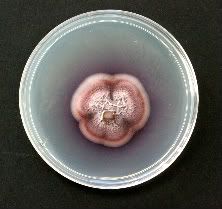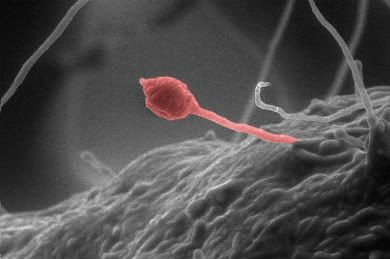Unique rainforest fungus makes bio-hydrocarbons, including diesel from cellulose
A unique fungus that makes diesel compounds has been discovered living in trees in the rainforest, according to a paper published in the November issue of Microbiology. The fungus is potentially a totally new source of green energy and scientists are now working to develop its fuel producing potential.
Gliocladium roseum lives inside the Ulmo tree in the Patagonian rainforest. The researchers were trying to discover totally novel fungi in this tree by exposing its tissues to the volatile antibiotics of the fungus Muscodor albus. Quite unexpectedly, G. roseum grew in the presence of these gases when almost all other fungi were killed. It was also making volatile antibiotics. Then when they examined the gas composition of G. roseum, the researchers were totally surprised to learn that it was making a plethora of hydrocarbons and hydrocarbon derivatives. The results were totally unexpected.
Many microbes produce hydrocarbons. Fungi that live in wood seem to make a range of potentially explosive compounds. In the rainforest, G. roseum produces lots of long chain hydrocarbons and other biological molecules. When the researchers grew it in the lab, it produced fuel that is even more similar to the diesel we put in our cars.
When crops are used to make biofuel they have to be processed before they can be turned into useful compounds by microbes, said Professor Strobel. G. roseum however can make myco-diesel directly from cellulose, the main compound found in plants and paper. This means if the fungus was used to make fuel, a step in the production process could be skipped:
 energy :: sustainability :: biomass :: bioenergy :: biofuels :: ethanol :: cellulose :: fungus :: genome ::
energy :: sustainability :: biomass :: bioenergy :: biofuels :: ethanol :: cellulose :: fungus :: genome ::
 Cellulose, lignin and hemicellulose make up the cell walls in plants. Lignin is the glue that holds the cellulose fibres together and makes the plant stand up. These compounds form the part of the plant that most animals cannot digest. They makes up non-foodstuffs like stalks, sawdust and woodchip. Nearly 430 million tonnes of plant waste are produced from just farmland every year; a huge amount to recycle. In current biofuel production, this waste is treated with enzymes called cellulases that turn the cellulose into sugar. Microbes then ferment this sugar into ethanol that can be used as a fuel.
Cellulose, lignin and hemicellulose make up the cell walls in plants. Lignin is the glue that holds the cellulose fibres together and makes the plant stand up. These compounds form the part of the plant that most animals cannot digest. They makes up non-foodstuffs like stalks, sawdust and woodchip. Nearly 430 million tonnes of plant waste are produced from just farmland every year; a huge amount to recycle. In current biofuel production, this waste is treated with enzymes called cellulases that turn the cellulose into sugar. Microbes then ferment this sugar into ethanol that can be used as a fuel.
Picture 1: Colorized environmental scanning electron microscope photo of Gliocladium roseum, an endophtic fungus that produces myco-diesel hydrocarbons. Credit: Gary Strobel.
Picture 2: Culture plate of Gliocladium roseum, an endophtic fungus that produces myco-diesel hydrocarbons. Credit: Gary Strobel.
References:
Gary A. Strobel, Berk Knighton, Katreena Kluck, Yuhao Ren, Tom Livinghouse, Meghan Griffin, Daniel Spakowicz and Joe Sears, "The production of myco-diesel hydrocarbons and their derivatives by the endophytic fungus Gliocladium roseum (NRRL 50072)". Microbiology 154 , 3319-3328; 2008, doi: 10.1099/mic.0.2008/022186-0
This is the only organism that has ever been shown to produce such an important combination of fuel substances. The fungus can even make these diesel compounds from cellulose, which would make it a better source of biofuel than anything we use at the moment. - Professor Gary Strobel, Montana State UniversityThe fungus, which has been named Gliocladium roseum, produces a number of different molecules made of hydrogen and carbon that are found in diesel. Because of this, the fuel it produces is called "myco-diesel".
Gliocladium roseum lives inside the Ulmo tree in the Patagonian rainforest. The researchers were trying to discover totally novel fungi in this tree by exposing its tissues to the volatile antibiotics of the fungus Muscodor albus. Quite unexpectedly, G. roseum grew in the presence of these gases when almost all other fungi were killed. It was also making volatile antibiotics. Then when they examined the gas composition of G. roseum, the researchers were totally surprised to learn that it was making a plethora of hydrocarbons and hydrocarbon derivatives. The results were totally unexpected.
Many microbes produce hydrocarbons. Fungi that live in wood seem to make a range of potentially explosive compounds. In the rainforest, G. roseum produces lots of long chain hydrocarbons and other biological molecules. When the researchers grew it in the lab, it produced fuel that is even more similar to the diesel we put in our cars.
When crops are used to make biofuel they have to be processed before they can be turned into useful compounds by microbes, said Professor Strobel. G. roseum however can make myco-diesel directly from cellulose, the main compound found in plants and paper. This means if the fungus was used to make fuel, a step in the production process could be skipped:
 energy :: sustainability :: biomass :: bioenergy :: biofuels :: ethanol :: cellulose :: fungus :: genome ::
energy :: sustainability :: biomass :: bioenergy :: biofuels :: ethanol :: cellulose :: fungus :: genome ::  Cellulose, lignin and hemicellulose make up the cell walls in plants. Lignin is the glue that holds the cellulose fibres together and makes the plant stand up. These compounds form the part of the plant that most animals cannot digest. They makes up non-foodstuffs like stalks, sawdust and woodchip. Nearly 430 million tonnes of plant waste are produced from just farmland every year; a huge amount to recycle. In current biofuel production, this waste is treated with enzymes called cellulases that turn the cellulose into sugar. Microbes then ferment this sugar into ethanol that can be used as a fuel.
Cellulose, lignin and hemicellulose make up the cell walls in plants. Lignin is the glue that holds the cellulose fibres together and makes the plant stand up. These compounds form the part of the plant that most animals cannot digest. They makes up non-foodstuffs like stalks, sawdust and woodchip. Nearly 430 million tonnes of plant waste are produced from just farmland every year; a huge amount to recycle. In current biofuel production, this waste is treated with enzymes called cellulases that turn the cellulose into sugar. Microbes then ferment this sugar into ethanol that can be used as a fuel.We were very excited to discover that G. roseum can digest cellulose. Although the fungus makes less myco-diesel when it feeds on cellulose compared to sugars, new developments in fermentation technology and genetic manipulation could help improve the yield. In fact, the genes of the fungus are just as useful as the fungus itself in the development of new biofuels. - Professor StrobelThe discovery also questions our knowledge of the way fossil fuels are made. The accepted theory is that crude oil, which is used to make diesel, is formed from the remains of dead plants and animals that have been exposed to heat and pressure for millions of years, added Professor Strobel. If fungi like this are producing myco-diesel all over the rainforest, they may have contributed to the formation of fossil fuels.
Picture 1: Colorized environmental scanning electron microscope photo of Gliocladium roseum, an endophtic fungus that produces myco-diesel hydrocarbons. Credit: Gary Strobel.
Picture 2: Culture plate of Gliocladium roseum, an endophtic fungus that produces myco-diesel hydrocarbons. Credit: Gary Strobel.
References:
Gary A. Strobel, Berk Knighton, Katreena Kluck, Yuhao Ren, Tom Livinghouse, Meghan Griffin, Daniel Spakowicz and Joe Sears, "The production of myco-diesel hydrocarbons and their derivatives by the endophytic fungus Gliocladium roseum (NRRL 50072)". Microbiology 154 , 3319-3328; 2008, doi: 10.1099/mic.0.2008/022186-0
 --------------
--------------
 Mongabay, a leading resource for news and perspectives on environmental and conservation issues related to the tropics, has launched Tropical Conservation Science - a new, open access academic e-journal. It will cover a wide variety of scientific and social studies on tropical ecosystems, their biodiversity and the threats posed to them.
Mongabay, a leading resource for news and perspectives on environmental and conservation issues related to the tropics, has launched Tropical Conservation Science - a new, open access academic e-journal. It will cover a wide variety of scientific and social studies on tropical ecosystems, their biodiversity and the threats posed to them.










0 Comments:
Post a Comment
Links to this post:
Create a Link
<< Home